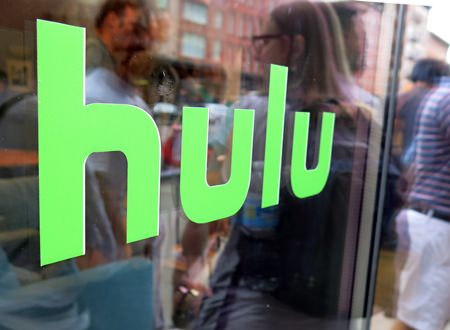New York (AP) – The Golden Age of Online Television may be in peril.
Streaming TV has gotten popular as several online services such as Netflix make past seasons of TV shows available for binge-watching, while Hulu offers episodes from the current season.
Now, some television companies are balking at giving them timely access to shows.
The big worry: Making streaming TV too pleasant might encourage viewers to cut back or drop their cable service. Cable and satellite companies now pay TV networks billions of dollars a year to carry their channels. In turn, TV production companies make a lot from licensing fees paid by the networks. Cord-cutting could jeopardize all of those arrangements, and the audience and ad revenue boost from the Internet might not be enough to make up for any losses.
 Some television companies are balking as more people watch shows online, and may start delaying the release of shows to streaming services like Netflix and Hulu. (AP Photo/Dan Goodman, File)
Some television companies are balking as more people watch shows online, and may start delaying the release of shows to streaming services like Netflix and Hulu. (AP Photo/Dan Goodman, File)
Time Warner Inc., which has both networks and a production business, has been exploring the possibility of holding back some of its DC Comics superhero shows such as “The Flash” and “Supergirl.” If it took that step, viewers might have to wait years to watch the most recent episodes online; now, they’re typically available no more than a year after airing.
Hulu may be next. The Wall Street Journal recently reported that Time Warner is in talks to invest in Hulu and has told Hulu’s owners that it wants to curtail current-season TV episodes, which Hulu now makes available as early as the next day.
It’s not yet clear what such restrictions might look like. Time Warner and Hulu didn’t respond to requests for comment, though Time Warner may reveal more of its digital strategy when it reports quarterly earnings Wednesday.
The tremors emanating from Time Warner are just the latest instance of established media companies looking to protect their established partners and deals, whether viewers like it or not.
Hulu already has pulled back in recent years. When it launched nearly a decade ago, the service offered most shows from its network parents the morning after they aired. These days, many Fox and ABC shows require a Hulu or cable subscription for next-day viewing. Otherwise, viewers have to wait eight days – or a month in the case of Fox’s “So You Think You Can Dance.” And for Fox, Hulu now has just the past four episodes – not five – for free.
All online services, meanwhile, have been dabbling in creating their own television shows. Netflix won accolades for such original shows as “House of Cards,” while Hulu commissioned a fourth season of “The Mindy Project” when Fox canceled it. Original shows help services set themselves apart from each other and could ease the impact of any pullback in traditional TV shows.
But for now, these services are mostly about giving viewers a chance to catch up on what’s been shown on traditional TV – and giving viewers less of a reason to tune in.
“To a certain degree, you can’t put the genie back in the bottle,” said Anthony DiClemente, an analyst at Nomura Securities. “Once people are accustomed to it, that’s going to be the expectation.”
Some holdbacks of shows online happen because online ads bring in less revenue than TV ads, but new measuring techniques and innovation could change that trade-off. 21st Century Fox CEO James Murdoch told investors Monday that while Fox was “interested in having fewer holdbacks,” as a supplier of content it needs “more flexibility with respect to how advertising innovation works and what we can do.”
Traditional cable and satellite TV services have been in slow decline for years, in part because younger audiences aren’t signing up and are turning to online options instead. The decline isn’t big enough to threaten cable and television companies immediately, but they are taking notice. And the numbers hide the fact that many subscribers are opting for cheaper packages with fewer channels.
“What we’re seeing is a constant game of tug-o-war,” said John Buffone, an analyst at the NPD Group.
As services like Netflix and Hulu boom, he said, television companies are looking for ways they can hold onto more of those streaming revenues themselves.
The changes are especially noticeable at Hulu, which is owned by parents of the very television networks – Fox, ABC and NBC – threatened by changes in the way we watch TV. Hulu has set itself apart by offering new TV episodes faster than its rivals; making viewers wait longer could limit its appeal.
“Hulu’s DNA has been recent episodes of TV shows,” said Glenn Hower, an analyst at the research firm Parks Associates.
The apparent anxiety at television companies is common to any industry that’s faced what Harvard business professor Clayton Christensen calls “The Innovator’s Dilemma.” That’s when established companies find their big, lucrative businesses undercut by innovative rivals with cheaper – and, at least at first, less profitable – alternatives. The big companies can’t embrace the new approaches without helping cannibalize their own cash cows.
Viewed through that prism, Hulu has been a mostly successful half-measure. Its biggest accomplishment may have been to help accustom people to paying for TV over the Internet. Given that it was established when piracy was rampant, that’s no small feat.
Though Hulu still offers ad-supported shows you can watch for free, more viewers are paying at least $8 a month for viewing on mobile and streaming-TV devices and for full current seasons of some shows. As of last April, the last time Hulu disclosed figures, it had 9 million paying subscribers, a 50 percent increase from the previous year. Netflix, meanwhile, had 45 million U.S. streaming subscribers at the end of 2015, a 14 percent increase.
Yet the traditional TV business remains sizable – and will remain so for years. Even with a 1 percent drop over the past year, 98.3 million U.S. households subscribe to cable or satellite, research firm MoffettNathanson estimates.
As a result, expanded streaming deals might not make up for what TV companies might lose if that big business continues to shrink. The fees that cable and satellite companies pay television networks and stations to carry their channels are estimated at $60 billion this year, up 6 percent from 2015, according to media research firm SNL Kagan.
From that standpoint, Hower said, it makes sense to cling to older, well-established partners – the cable companies.




